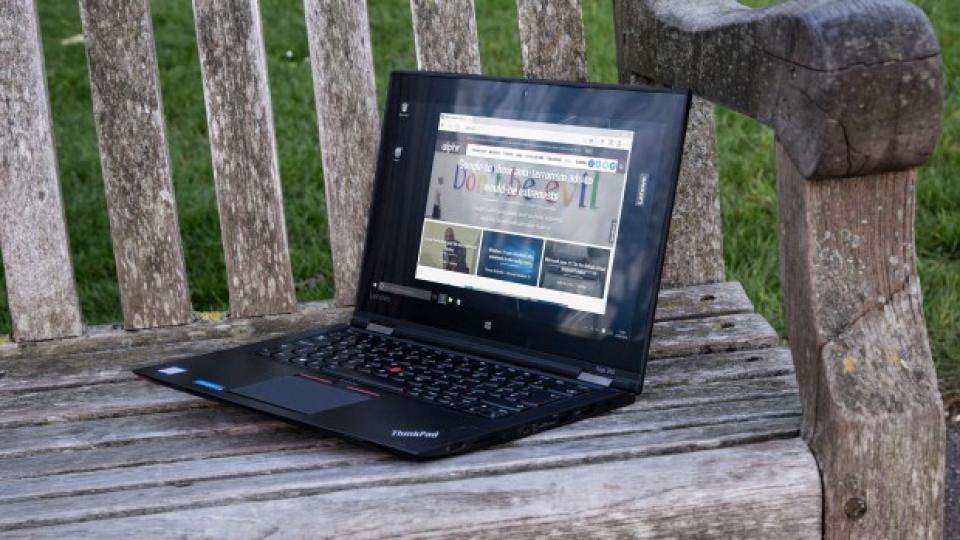There’s something endlessly reassuring about a ThinkPad. In some ways, little has changed for decades: the staunchly unfashionable design and retro logos hark back to the devices of IBM days, and even the name stretches way back to the early days of IBM in the 1920s – it was born from the company’s early slogan, “Think”. Now, in 2016, the ThinkPad Yoga 260 marries that past with the technological cutting-edge.
Lenovo ThinkPad Yoga 260: Design
Following in the footsteps of HP’s rather lovely EliteBook Folio 1020 , the ThinkPad Yoga 260 delivers its compact business thrills in a 12.5in-screened package. That in itself gives it a slight edge over the myriad 13.3in devices on the market. It’s just that tiny bit smaller and easier to wield in one hand, even if it’s no lighter than most, weighing an unremarkable 1.33kg. It is a certified hard nut, though. While there’s a little flex in the Yoga 260’s body, the MIL-STD-810G certification suggests this is a device that will bounce more often than it breaks.
The ThinkPad Yoga 260 boasts a now familiar party trick. Its flexible hinge allows it to contort itself from a standard laptop and pirouette through tent, stand and tablet modes. Where the Yoga 260 deviates from the usual Yoga formula, however, is that it also squeezes in a powered stylus that slots into its right-hand edge. Neatly, the stylus charges its internal battery while it’s slotted home and, in a further sleight of hand, the keyboard’s keys automatically recede as you fold the screen back past the halfway mark, which neatly avoids that slightly weird feeling of pressing keys when the Yoga 260 is used in tablet mode.
Lenovo ThinkPad Yoga 260: Connectivity
It really is business as usual elsewhere. While you’d reasonably expect some compromises, given the Yoga 260’s size, Lenovo has done a cracking job of cramming in all the connectivity and security options you’d expect from a device destined for the office.
The presence of two USB 3 ports, HDMI, mini-DisplayPort, and a microSD slot isn’t especially remarkable, but the proprietary Onelink+ port is. An adapter in the box uses it to add Ethernet and a VGA output, but it’s also possible to hook up one of Lenovo’s docking stations, which add up to six more USB ports, gigabit Ethernet, extra DisplayPort and DVI video outputs, and simultaneously charge the internal battery.
Needless to say, wireless networking is well catered for, with the choice of a Broadcom or an Intel 802.11ac chipset (the latter of which comes in both standard and vPro flavours), and you get Bluetooth 4.1 and support for NFC regardless of which you choose.
Curiously, although there’s a SIM slot, our review unit wasn't equipped with a 4G adapter, and there was no sign of it being an optional extra on Lenovo’s website. I’ll have to chase Lenovo and confirm when, and indeed if, the UK will be seeing a 4G-enabled version of the Yoga 260. And last but not least, security options are also on the money. A fingerprint reader and TPM 2.0 are equipped as standard, and you can add a full-sized smart card reader for £14. So far, so good.
Lenovo ThinkPad Yoga 260: Performance
Inside, the Yoga 260 blends the usual high-end concoction of Skylake CPUs, DDR4 RAM and M.2 SSDs. Buy the £889 entry-level model and you’ll get a Core i3-6100U with a 192GB SSD. Bump your budget to £1,010 and you'll get a Core i5 with a 256GB drive, and the range-topping £1,290 model is equipped with a Core i7 and 512GB of speedy storage. All the models are highly configurable, though, and it’s worth noting the various upgrade prices are very reasonable. For instance, going from 8GB to 16GB of RAM costs only £62.40.
Lenovo sent us a Core i7 model with a 256GB SSD and 8GB of RAM. The only disappointment is that the Yoga 260 is equipped with a standard SATA M.2 SSD – the model I saw last year at IFA had a super-quick NVMe SSD. With sequential read speeds of around 450MB/s, the Lite-On drive is around half the speed of its NVMe cousins. Hopefully, the larger 512GB SSD option may be of the faster variety since Lenovo’s specifications mention that “some” drives are NVMe and some SATA, even if it doesn’t clarify which. I'll be pressing Lenovo for an answer.












